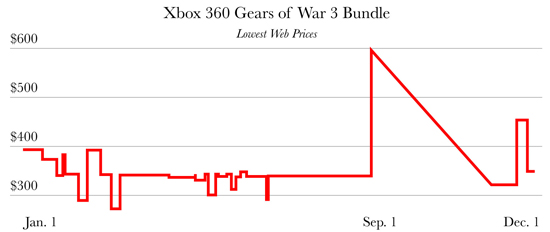Nineteen
How to Outguess Retail Prices
Is now a good time to buy a plasma TV, an airline ticket, or an apartment? Those with the knack of outguessing sales can live larger for less. That knack is becoming more and more important. Few people realize how often Amazon, Walmart, Target, and other big retailers change their prices. Most consumer prices are set by software that fluidly adjusts to competitor prices, consumer demand, and the calendar. Buyers who pat themselves on the back for Googling the “best” price often fail to consider the time element. Those who pay the best price at the wrong time can shell out double what someone else did a few days before or afterward.
On the next page is a price chart for a Microsoft Xbox 360 (Limited Edition Gears of War 3 bundle) as reported by the price-tracking app Decide.com. These are the lowest prices you could have obtained on the Web at any given moment in 2012. Though erratic, the price is clearly not a random walk. That means it’s predictable to a degree.
The average rock-bottom Web price for this Xbox bundle was $379. The price hovered close to that average for most of the year. You could have paid as little as $280 or as much as $600. The chart’s main feature is the sharp increase on September 1, followed by a decline to Black Friday. This is a not-uncommon pattern for holiday gift items. Retailers raise the price so that it can be lowered for holiday “sales.” The Xbox price sank to a favorable level for Black Friday and Cyber Monday, and then went abruptly up to $462. It would have been unwise to buy at that price. Bargain hunters shop on Black Friday and a few days afterward. Those shopping just after that are usually less price sensitive. But prices tend to revisit the Black Friday lows before Christmas, assuming the item remains in stock. Buyers and retailers are playing a game of chicken. Some buyers will blink and pay a high price to be sure of having an Xbox under the tree. Others will be willing to gamble and wait for the prices to come down. On December 1, Decide.com’s outguessing machine was predicting that the Xbox bundle’s price would “hold steady or drop ($133 on avg.)” over the following two weeks with 93 percent confidence. In fact, by December 4 it had dropped to $349.99.

Retail prices have become an emergent phenomenon. The retailers themselves don’t know exactly what’s going to happen next. The upward and downward jags in the chart are the result of individual sellers undercutting the competition or raising prices. These short-term price jitters are nearly impossible to predict. The scale of the biggest price changes is reasonably predictable.
For the most part, prices are confined to an envelope. Retailers prefer to sell at a markup to the wholesale cost. Even when they don’t do that—when they get into a price war or intentionally sell at a loss to build traffic—they aren’t going to allow themselves to lose too much money. This limits how far the price of a popular product can drop.
There is also a limit to how high prices can go. Should retailers get greedy and build too much profit into their pricing, somebody will undercut them and win most of the business.
Hence the envelope. When the price is at the low end of a range, you can be pretty sure you’re getting a good deal. When it’s at the high end, you should wait for prices to fall. It’s that simple—but most buyers have no clue what the envelope is.
That’s why price-checking apps are valuable. A good rule of thumb for many products is to never pay more than the average of the lowest Web prices over the past year.
There are exceptions, one being smartphones, tablets, high-end TVs, and other tech gadgets that become quickly obsolete with the introduction of a new model. For these purchases you need to be aware of the new product cycle, and the apps help there, too.
Recap: How to Outguess Retail Prices
• Use a price-tracking app or site (like Decide.com) for big-ticket purchases. Never pay more than the past year’s average-lowest Web price.
• Buy anytime you find a 20+ percent discount from the average best price over the past year. It probably won’t last long.